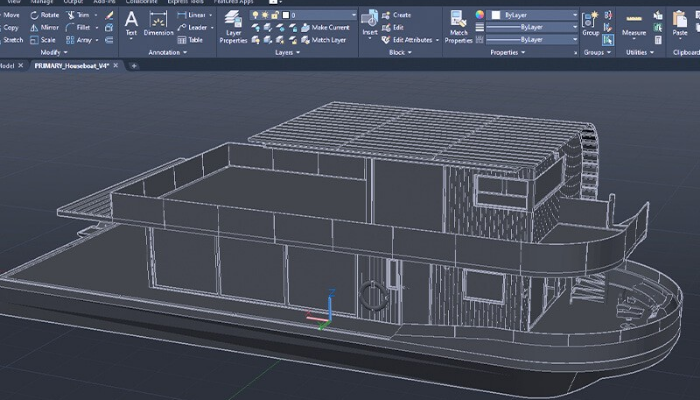Equipped with the right applications, a computer can be of great help in virtually any domain of activity. When it comes to designing and precision, no other tool is as accurate as a computer. Moreover, specialized applications such as AutoCAD give you the possibility to design nearly anything ranging from art, to complex mechanical parts or even buildings.
Suitable for business environments and experienced users
After a decent amount of time spent installing the application on your system, you are ready to fire it up. Thanks to the office suite like interface, all of its features are cleverly organized in categories. At a first look, it looks easy enough to use, but the abundance of features it comes equipped with leaves room for second thoughts.
Create 2D and 3D objects
You can make use of basic geometrical shapes to define your objects, as well as draw custom ones. Needless to say that you can take advantage of a multitude of tools that aim to enhance precision. A grid can be enabled so that you can easily snap elements, as well as adding anchor points to fully customize shapes.
With a little imagination and patience on your behalf, nearly anything can be achieved. Available tools allow you to create 3D objects from scratch and have them fully enhanced with high-quality textures. A powerful navigation pane is put at your disposal so that you can carefully position the camera to get a clearer view of the area of interest.
Various export possibilities
Similar to a modern web browser, each project is displayed in its own tab. This comes in handy, especially for comparison views. Moreover, layouts and layers also play important roles, as it makes objects handling a little easier.
Sine the application is not the easiest to carry around, requiring a slightly sophisticated machine to properly run, there are several export options put at your disposal so that the projects itself can be moved around.
Aside from the application specific format, you can save as an image file of multiple types, PDF, FBX and a few more. Additionally, it can be sent via email, directly printed out on a sheet of paper, or even sent to a 3D printing service, if available.
To end with
All in all, AutoCAD remains one of the top applications used by professionals to achieve great precision with projects of nearly any type. It encourages usage with incredible offers for student licenses so you get acquainted with its abundance of features early on. A lot can be said about what it can and can't do, but the true surprise lies in discovering it step-by-step.

AutoCAD Crack+ Download
The first version was originally licensed for use only in the automotive industry. For the first ten years or so, it was the only CAD available on the market for drafting applications.
In late 1999, after years of research and development, AutoCAD was introduced for the architecture and civil engineering industry. In its first decade, AutoCAD released three major releases of architectural design software. These releases were named Architectural Desktop, Architectural Workshop, and Architectural Center. These are collectively known as «AutoCAD Architecture.»
AutoCAD Architecture had 2D, 3D, and 4D modeling capabilities, with the latter three being later releases. In addition to architectural applications, AutoCAD Architecture has also been used for landscape design, interior design, electrical and mechanical design, site management, and engineering applications.
In 2002, AutoCAD Architecture was renamed AutoCAD MEP, and its overall capabilities and functionality were dramatically expanded with the release of AutoCAD MEP 2000. This release greatly improved the compatibility of AutoCAD Architecture and other applications used in the electrical, mechanical, and plumbing design industries. AutoCAD MEP 2000 also offered capabilities for the design of buildings, bridges, roads, and other infrastructure.
In 2007, Autodesk introduced the name «AutoCAD» for the product line that includes AutoCAD Architecture and AutoCAD Mechanical.
Release history
History timeline
Earlier releases
As stated above, AutoCAD was originally released in December 1982 as a desktop app running on microcomputers with internal graphics controllers. These microcomputers were known as «mainframe computers,» and they were typically mainframe and minicomputers with dedicated graphics terminals for users to work at. The CAD operator worked at a separate graphics terminal while drawing lines, drafting, and viewing documents.
CAD users were traditionally very important in the automotive industry. At that time, AutoCAD was the only CAD available for drafting, and it was required for companies manufacturing the Cadillac and other luxury vehicles.
In the mid-1980s, most CAD companies introduced standalone CAD terminal applications, which were basically desktop apps running on mainframe computers. When CAD users at different locations work with separate CAD terminal applications, most use the computer to view and modify a drawing on a monitor, and use separate mouse and keyboard devices to control the drawing.
In the early 1980s, computer graphics technology was also very expensive. As a
AutoCAD Crack + For PC
Culture and history
AutoCAD has been a success in the marketplace, but some regard it as a stifling, bureaucratic, ideological commitment. AutoCAD came about when Bill Gates saw how easy it was to create drawings and wanted to create software that would save his design team time on repetitive tasks. He asked Pat McGregor, a programmer at the University of Michigan, to create software that could do the same, and McGregor initially wrote and used a program called «Draw».
The documentation contained with AutoCAD was initially created by Gregg Tavares, an engineering student at the University of Michigan. Gregg started his documentation work in 1972, initially intended to be released in book form, but was ultimately developed into a separate software product in 1981.
In 1981, Gregg changed the original documentation into a print-on-demand (POD) product called «SmartDraw». A friend of Gregg’s, Tom Bray, then created the look and feel of the product, and named it «AutoCAD». After AutoCAD became a hit, Gregg decided to start a consulting company and formed «Tavares Consulting», although Tavares and the original «Draw» documentation remained in tact.
After a few years, Gregg decided to start up a new consulting company, called «Tavares Inc.», which gave him more room to develop and distribute the drawing and documentation. He created a separate website with supporting documentation, marketing materials, and samples for potential clients. The website was eventually replaced by a traditional autobuild documentation website called «The Architecture Studio». As a result of several companies combining their efforts, the current product is known as «AutoCAD».
With the advent of the personal computer, in the 1980s and 1990s, many people chose AutoCAD as their drafting tool because of its ease of use and its relative affordability. Since then, AutoCAD has continued to expand with updates, changes, and functionality. The current version of AutoCAD, 16.5, was released on 22 April 2019.
History
AutoCAD was first released on September 22, 1982, by Autodesk, Inc. to the general public. Its predecessor, «Draw», was originally written by Pat McGregor for his student, Gregg Tavares. Gregg is the author of the AutoCAD documentation as well as the development of the original «Draw» software. In 1982, Gregg also began work on the «Draw» documentation, which became a print-on-demand book
ca3bfb1094
AutoCAD Free
# How to use the activated one
Create a shortcut to the executable and data files with the following destination
What’s New in the AutoCAD?
Get a PDF preview of the current drawing’s markup. In this preview, you can specify the printing settings. (video: 1:15 min.)
Set up your drafting software’s system tray so that you can easily work while you sketch or annotate drawings. Use AutoCAD in the background to capture detailed dimension and other annotations that appear on the drawing page. (video: 1:30 min.)
Use a stylus and pen or finger to draw on-screen during the drawing session. You can draw even if your mouse isn’t ready to move. Mark up drawings using a drawing tablet or smart stylus. (video: 1:30 min.)
Import part or assembly drawings that can include dimensioned notes, drafting instructions, and annotated notes. The markup added to the parts that you import in the drawing can be completely customized. (video: 1:30 min.)
Import an assembly drawing and markup notes. To keep the drawing modular, you can selectively import parts and lines based on the selection filter, while you add notes to the drawing parts with the Markup Assist tool. (video: 1:30 min.)
Export a 3D mesh surface to the Windows clipboard or share it with others through the Windows Clipboard API. You can use the added surface as a group to help you edit with the Surface Control Editor or the Surface Lattice tool. You can also use the surface as a template for other drawings. (video: 1:30 min.)
Use the Surface Control Editor to create 3D surfaces to mark up and annotate your drawings. The 3D surface contains a layer with all the annotations, which you can edit, move, rotate, and hide. You can add surface control annotations (e.g., arrows, circles, and scale) and view them in a drawing. (video: 1:30 min.)
Create a surface that you can use to annotate your drawing. You can create a surface for dimension notes, drafts, and so on. (video: 1:30 min.)
Create a completely customizable corner and line style, including the color of the lines. (video: 1:30 min.)
Use the surface control to place markings in your drawing. For example, you can draw compass points and text, plot coordinates and angles, and use colors to highlight drawing elements. (video: 1:30 min.)
Use the Surface Latt
https://ed.ted.com/on/XHxFy65e
https://ed.ted.com/on/VWCAvJZp
https://ed.ted.com/on/WQjTUaYo
https://ed.ted.com/on/thLrULOS
https://ed.ted.com/on/gPBwANiS
System Requirements For AutoCAD:
OS: Windows 7 64-bit, Windows 8.1 64-bit, Windows 10 64-bit
Processor: Intel Core i5 or better
Memory: 4 GB RAM
Graphics: NVIDIA Geforce GTX 760 or better
DirectX: Version 11
Storage: 12 GB available space
How to Install:
1. Download MCME Controller.exe and move it to your Game folder.2. Uninstall MCME Controller on your PC.3. Open CMD (Start -> All Programs -> Accessories -> Command Prompt) and
https://therootbrands.com/wp-content/uploads/2022/07/AutoCAD-6.pdf
http://cyclades.in/en/?p=123131
https://www.dovesicanta.it/wp-content/uploads/2022/07/valelg.pdf
https://twhealthcare.info/wp-content/uploads/2022/07/AutoCAD-5.pdf
https://www.iltossicoindipendente.it/2022/07/23/autocad-crack-free-registration-code-latest/
https://latinbusinessyellowpages.com/wp-content/uploads/2022/07/AutoCAD_Crack__Registration_Code_For_PC.pdf
http://www.cpakamal.com/autocad-crack-free-2022/
https://ninja-hub.com/autocad-2021-24-0-crack-with-license-code-win-mac/
https://awamagazine.info/advert/autocad-20-0-crack-mac-win/
https://jewishafrica.news/advert/autocad-crack-for-pc-2/
https://elc-group.mk/2022/07/23/autocad-crack-15/
https://smartsrebate.com/wp-content/uploads/2022/07/estoist.pdf
https://baukultur.plus/wp-content/uploads/2022/07/guatleon.pdf
https://idenjewelry.com/wp-content/uploads/AutoCAD_Crack___Download_PCWindows_Updated.pdf
http://kinectblog.hu/autocad-2020-23-1-crack-with-serial-key-free-2022.html
http://www.studiofratini.com/autocad-23-1-activation-code/
https://theoceanviewguy.com/autocad-keygen-for-lifetime/
https://clarissaviaggi.com/wp-content/uploads/2022/07/linezado.pdf
https://ptoart.com/wp-content/uploads/2022/07/AutoCAD__Crack_Patch_With_Serial_Key_Free_Download_PCWindows.pdf
https://logocraticacademy.org/autocad-crack-free-download-mac-win/
 Periodistas Agroalimentarios Periodistas Agroalimentarios
Periodistas Agroalimentarios Periodistas Agroalimentarios

